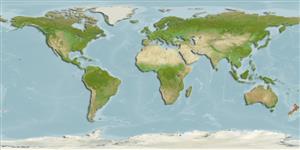>
Blenniiformes (Blennies) >
Tripterygiidae (Triplefin blennies) > Tripterygiinae
Etymology: Notoclinops: Greek, noton = back + Greek, klinein, kline = sloping and also bed, due to the four apophyses of sphenoid bone + Greek, ops = appearance (Ref. 45335).
Environment: milieu / climate zone / depth range / distribution range
Ecologie
marien demersaal; diepte 0 - 40 m (Ref. 9003). Subtropical
Southwest Pacific: mainland New Zealand.
Grootte / Gewicht / Leeftijd
Maturity: Lm ? range ? - ? cm
Max length : 4.4 cm SL mannelijk / geslacht onbekend; (Ref. 13227)
Korte beschrijving
Determinatiesleutels | Morfologie | Morfometrie
Dorsale stekels (totaal) : 20 - 23; Dorsale zachte stralen (totaal) : 10 - 13; Anale stekels: 1; Anale zachte stralen: 24 - 25. Pinkish over head and body with faint brown lines on head, nine evenly spaced reddish brown vertical bands on body. Dorsal fins pinkish with a thin colorless stripe running horizontally. Distinguished from other triplefins, other than Notoclinops caerulepunctus by the bright blue eyes.
Adults prefer areas of broken rock, steep rock faces and overhangs in areas without large algae and a thick cover of crustose coralline algae. They feed on small crustaceans (e.g. amphipods and copepods). They remove parasites from larger fish. Males are territorial during the breeding season dutifully guarding the eggs in the nests (Ref. 9003). Eggs are hemispherical and covered with numerous sticky threads that anchor them in the algae on the nesting sites (Ref. 240). Larvae are planktonic which occur primarily in shallow, nearshore waters (Ref. 94114).
Levenscyclus en paargedrag
Maturiteit | Voortplanting | Paaien | Eieren | Fecunditeit | Larven
Fricke, R., 1994. Tripterygiid fishes of Australia, New Zealand and the southwest Pacific Ocean (Teleostei). Theses Zool. 24:1-585. (Ref. 13227)
Status op de Rode Lijst van het IUCN (Ref. 130435: Version 2024-2)
Gevaar voor de mens
Harmless
Gebruik door de mens
Visserij: van geen belang
Tools
Speciale rapporten
Download XML
Internetbronnen
Estimates based on models
Preferred temperature (Ref.
123201): 15.1 - 19.5, mean 17.7 °C (based on 24 cells).
Fylogenetische diversiteitsindex (Ref.
82804): PD
50 = 0.6250 [Uniqueness, from 0.5 = low to 2.0 = high].
Bayesian length-weight: a=0.00661 (0.00340 - 0.01283), b=3.10 (2.93 - 3.27), in cm total length, based on LWR estimates for this species & (Sub)family-body (Ref.
93245).
Trofisch niveau (Ref.
69278): 3.3 ±0.0 se; based on diet studies.
Weerstandsvermogen (Ref.
120179): Hoog, minimale populatieverdubbelingstijd minder dan 15 maanden (Preliminary K or Fecundity.).
Fishing Vulnerability (Ref.
59153): Low vulnerability (10 of 100).
Nutrients (Ref.
124155): Calcium = 606 [247, 2,131] mg/100g; Iron = 3.65 [1.57, 7.97] mg/100g; Protein = 18.7 [17.2, 20.0] %; Omega3 = 0.43 [0.15, 1.27] g/100g; Selenium = 36.2 [9.7, 109.1] μg/100g; VitaminA = 9.12 [1.81, 48.47] μg/100g; Zinc = 2.66 [1.34, 4.66] mg/100g (wet weight);
